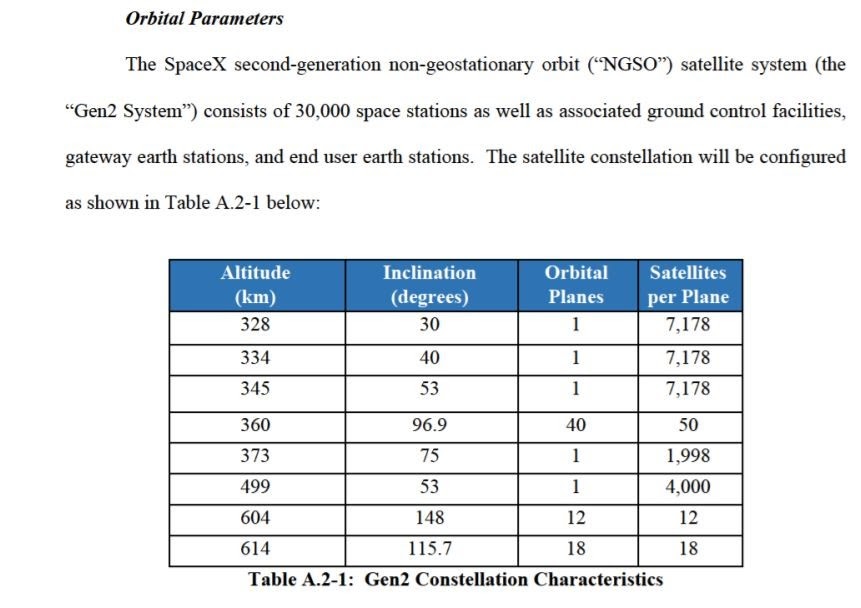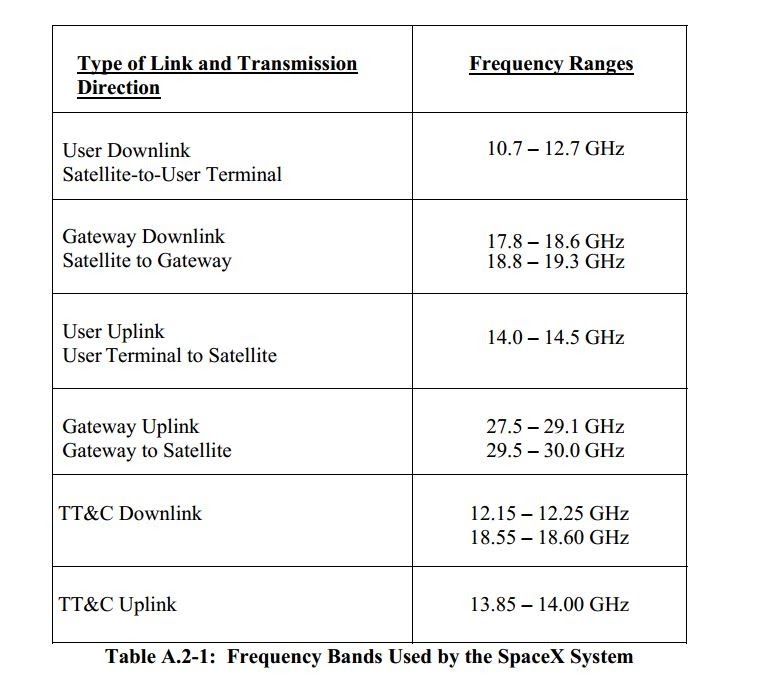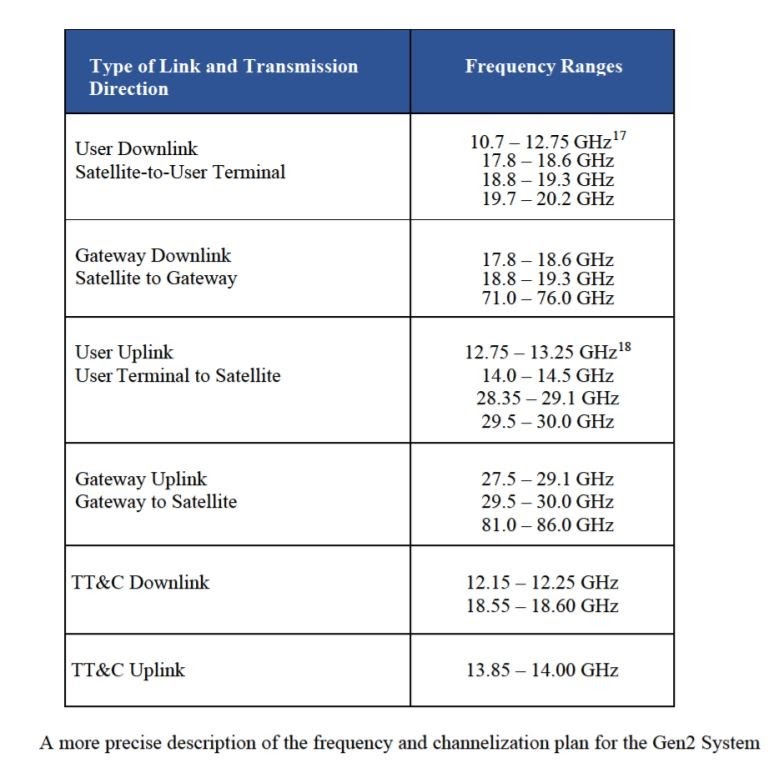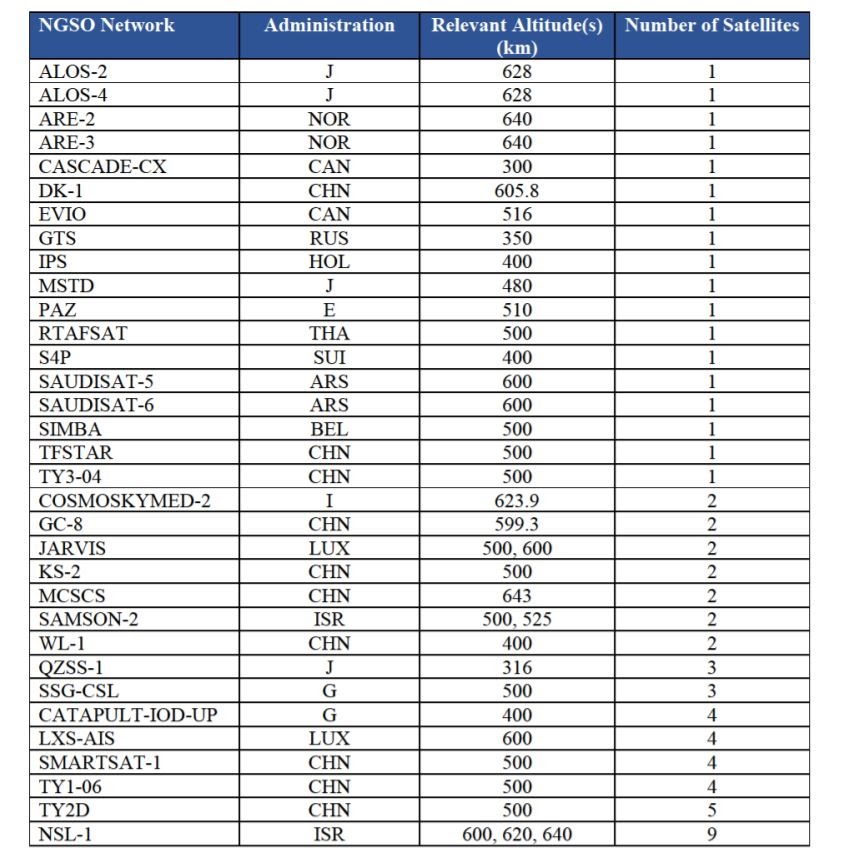I suggest that you familiarize yourself with the previously posted materials on the Starlink (SL)
project : Part 1. The birth of the project ‣ Part 2. SL network ‣ Part 3. Ground complex ‣ Part 4. Subscriber terminal ‣ Part 5. State of the SL grouping and closed beta testing ‣ Part 6. Beta-testing and service for customers ‣ Part 7. Bandwidth SL and RDOF program network ‣ Part 8. Installation and inclusion of subscriber terminal ‣ Part 9 service in markets outside the US ‣ Part 10. SL and the Pentagon ‣ Part 11. SL and astronomers ‣ Part 12. Space debris problems‣ Part 13. Satellite network delay and access to radio spectrum ‣ Part 14. Inter-satellite links ‣ Part 15. Rules of service ‣ Part 16. SL and weather
Starlink-2.0. Second generation of the system
Here we will talk about a new round of applications for the use of the frequency resource in the United States for satellite networks in low and medium orbit. Previously published in LJ part devoted primarily OneWEB and Telesat. It is advisable to start reading from it in order to understand the whole picture, and today we will consider the SpaceX application .
What did SpaceX ask for in its new FCC filing in the US?
First of all, the application is distinguished by the fact that if OneWEB and Telesat simply scaled their networks (it is banal to increase the number of satellites 5..13 times, without changing, by and large, neither the frequency range, nor the orbit, and without going into almost any details) , then SpaceX has a really NEW application, and not just more of the same satellites.
And SpaceX rightly talks about Gen2 (the second generation of the system).
So here is a table with Starlink-2 network parameters.

If you imagine it in orbit, it will look like this:
What's new?
1. Unlike the first generation, the subscriber terminal in Gen2 will operate not only in Ku (11/14 Gigahertz), but also in Ka (18/30 Gigahertz). At the same time, subscriber terminals for the first generation will also operate with the second generation satellites.
Here are the frequencies of the first generation Starlink:

And here are the frequencies for StarLink Gen2:

What does it give ?? Gives more bandwidth. The Ku-band is divided into 2 parts for BSS Broadcast Satellite Service (television broadcasting) and FSS Fixed Satellite Service (satellite communications), this is a total of 10 700 MHz to 12 700 MHz. Total 2000 Megahertz in the direction from the satellite to the subscriber. In Gen2, 1800 MHz in the Ka-band will be added to 2000 MHz in Ku.
2. In order to "lift" twice as much information from the Earth to the satellite, SpaceX decided to use a new (never before used in satellite communications) E-frequency range on the gateways - this is 81-86 Gigahertz (or 71-76 Gigahertz in the opposite direction ). Here, for Fixed Satellite Service (satellite communications), you can use not 500 MHz as in Ku, but 10 times more - 5000 MHz. It should be noted that now in the USA this range is used only for the organization of terrestrial radio relay links (radio relay lines) of radio bridges (radio channels between towers), there are only about 19,000 such devices in the USA. SpaceX must select the location of its gateways so as not to interfere with these radio bridges.
3. Compared with the first generation of satellites, each of which can operate 8 separate beams from the satellites towards the Earth, the second generation will have more of them (30 beams working for reception (of which 2 beams for control and telemetry) and 32 beams for transmission (2 telemetry and control)). This number of service beams is divided into feeder (between the satellite and the gateway) and service (between the satellite and the subscriber terminal).
Due to this, each second-generation satellite will have 3 (three) times more bandwidth than the first-generation satellite.
What else can you find interesting in their application:
4. The subscriber terminal can receive a signal of several separate beams with a total bandwidth of up to 2000 MHz (equivalent speed of at least 6 Gigabits) and transmit in a band up to 125 MHz (equivalent speed of at least 125 Mbit).
5. SpaceX says it has reached an agreement with the US Government agencies (including the Department of Defense) on the joint use of the Ka-band, and is confident that it can reach an agreement for the use of this range by Gen2 satellites.
6. SpaceX has not yet prepared and submitted to the FSS information about the 2nd generation Starlink system, which must be reported to the International Telecommunication Union. This will be done at an appropriate time for this, and SpaceX is ready to pay all costs associated with publishing data about its system in the ITU catalog.
7. In each launch of the satellite, Starlink SpaceX uses 4 assemblies for attaching the satellite under the fairing, each assembly consists of 2 aluminum light rods 6 meters long and 1.5 inches in diameter. The lifetime of these rods in orbit is no more than 36 days, and the probability of collision with any other object is 0.00000000653.
8. To protect against space debris and micrometeorites, all important elements of the satellite are protected by an aluminum shield 1 mm thick. At the same time, even if the screen and tanks with krypton are pierced, it will not cause an explosion and the formation of debris with a diameter of more than 1 mm.
9. Many of the airborne command radio line receivers, telemetry transmitters and electronics that control the satellite are redundant to prevent loss of control of the satellite in flight. Calculations using SpaceX's own method show that the probability of loss of control of the satellite due to a collision with space debris with a diameter of more than 1 mm is 0.000776 for the entire period of operation of the satellite.
10. SpaceX will monitor fuel tanks and batteries during operation and will not discharge fuel tanks and batteries at the end of operation. SpaceX plans to send satellites into the atmosphere for complete combustion while operating, considering this the safest option to prevent the creation of space debris.
11. SpaceX will constantly monitor the orbits of its satellites and calculate the probability of their collision with known objects of space debris and other satellites. If the probability of a collision is more than 0.001%, a Starlink satellite maneuver will be undertaken to change its orbit to a safe one.
12. Starlink satellites use GPS and other sensors to determine their location.
13. SpaceX undertakes to coordinate the movement of its satellites with all other non-GSO systems that have applied to the FSS, including Kuiper (its altitudes are 590, 610 and 630 km), as well as other non-US 54 constellations and individual satellites operating / crossing these heights registered in the ITU catalog.

I was amazed by the number of countries that have satellites in this orbit (or applications to ITU for placing satellites there)
14. The Starlink satellites will completely burn up in the atmosphere, and particles that reach the Earth's surface will have an energy of no more than 15 Joules, that is, the risk of injury for a person is zero.
15. Satellites of the 2nd generation will have regular inter-satellite communication channels.
16. Typical latency will be no more than 50 milliseconds.
17. Placing satellites in 360 km orbits will ensure that the satellite, in the event of a malfunction, will release its orbit (burn up in the atmosphere) in just three months.
18. Thanks to the point above, the orbits with an altitude of 360 km are among the "cleanest" and the probability of a collision of satellites on it is 21000 times less than in an orbit with an altitude of 800 km.
19. To reduce interference in astronomical observations, satellites of the second generation will: firstly, rotate around their axis at the time of movement into a working orbit, and secondly, their solar batteries will fold in a special way. Both of these measures will ensure that the time when a train from launched satellites can be seen by an observer from Earth (without a telescope) is less than a week. These satellites will also use a special coating to reduce Albedo by 55% and a sun visor. Also, the lower orbital altitude of the 2nd generation satellites will ensure that they will leave the angle of observation by Astronomers faster than satellites in higher orbits.
20. The subscriber terminal will be extremely easy to turn on and it will consist of 2 steps: point to the sky and turn it on.
21. Due to the large number of satellites in the sky area visible to the subscriber terminal, the terminal will be able to select for operation those satellites that are not shaded for it by trees or taller buildings, that is, the system will receive very high flexibility. In addition, the 2nd generation system will have Artificial Intelligence, which allows it to disable / select those beams / satellites for work with a specific subscriber that do not interfere with other systems in low or geostationary orbit.
That's all, in general. As I understand it, the general goal of creating a second-generation Starlink satellite network is to provide the user with a level of service (in terms of latency and speed) at the level that residents of megalopolises in the United States now have, using optics or the future 5G cellular network.
If we talk about practical implementation, then in addition to the issue of managing and coordinating the entire grouping, the rest does not seem extremely difficult, but it requires huge investments and may be eligible for implementation only if the first generation Starlink network is commercially successful in the United States. At the same time, today there is definitely no 100% guarantee of such success.